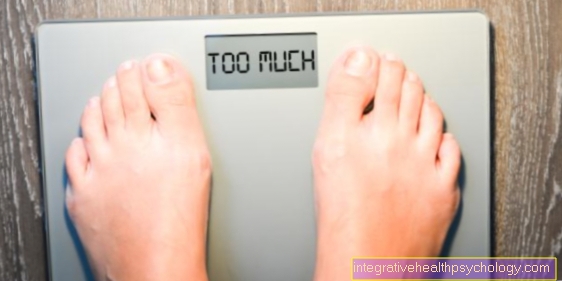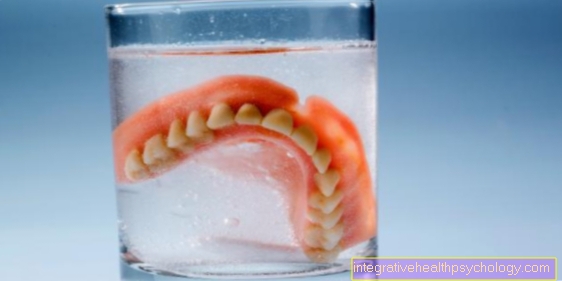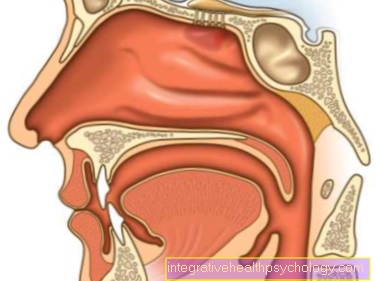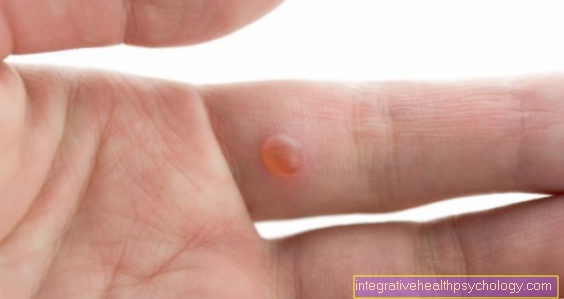Duration of a wisdom tooth operation
introduction
Evolutionarily, human skulls are getting smaller and smaller, which means that there is often too little space in the upper and lower jaw for wisdom teeth. Therefore, wisdom teeth grow crookedly or cannot erupt at all, which can shift them and cause discomfort. Nowadays it is diagnosed at an early stage whether wisdom teeth have enough space or whether they need to be removed prophylactically before any symptoms arise.

A wisdom tooth operation is considered a routine procedure by the dentist and oral surgeon, which can be limited to a duration of around twenty minutes per tooth. The procedure can be performed under local or general anesthesia. Experience reports from acquaintances or the Internet often put patients off before the operation, so that they wait too long and complaints arise. The complication rate is low and regeneration can take place without any pain or swelling. In dentistry, it is advisable to have wisdom teeth removed between the ages of sixteen and twenty-fifth, as this is when the wound healing ability is at its best.
Read more on the topic: Operation on the wisdom tooth
Duration of anesthesia
Anesthesia during a wisdom tooth operation is maintained until the oral surgeon or dentist as surgeon finishes the removal. Then the anesthesia is drained and an agent is injected, which neutralizes the effect and brings the patient back to consciousness. For a wisdom tooth operation, an anesthetist must always be present to monitor the patient's anesthesia and vital functions. Therefore, anesthesia can only last half an hour or can only be removed after two hours, depending on how complex the operation is.
Duration of pain
The duration of pain is usually associated with the duration of the swelling and depends on many factors. Complication-free operations and regeneration often result in no pain at all. If pain occurs, it is most severe in the first two days after the procedure and then gradually decreases. The pain can be caused by irritation of the neighboring teeth or the pain of the wound, but is no longer noticeable when taking ibuprofen.
Read the article on the topic: Pain after a wisdom tooth operation
It is also helpful to take a painkiller directly after the procedure so that the pain is buffered after the anesthesia has subsided. With complications in wound healing and infections, inflammatory pain can persist for a longer period of time. Alveolitis sicca, an empty, inflamed tooth socket, is also considered a painful complication. If there are complications, pain of one to two weeks is the norm. If the pain is unbearable, the practitioner must be consulted, who may reduce the pain with medication if necessary.
Read more on the topic: Inflammation after a wisdom tooth operation
Duration of the swelling
The duration of swelling after a wisdom tooth operation is variable. While some patients do not develop any swelling at all, others may experience a reddened swelling that will take time to resolve. The duration of the swelling is primarily present in the first week after the procedure, but it subsides more and more day by day. If the swelling feels hard and is getting bigger and bigger, the treating dentist or oral surgeon must be consulted immediately, as there is a risk of an infection complication and in the worst case it can lead to sepsis.The surgeon should also be seen if the swelling persists for more than two weeks.
Find out more about the topic: Swelling after a wisdom tooth operation
How long should you cool down after the operation?
The cooling after the wisdom tooth operation has a decongestant effect and counteracts inflammation. It is important, however, that cooling is carried out in short intervals so that the body does not feel hypothermic. The reaction would be that the blood pressure is increased and more blood flows through the hypothermic vessels, which means warming. This warming in turn promotes swelling, inflammation and the spread of infection. Therefore, you should only cool for five to a maximum of ten minutes at a time and then pause for three quarters of an hour. Furthermore, the head should always be kept high so that too much blood does not flow into the head, which in turn leads to warming.
Duration of bleeding
The attending dentist or oral surgeon does not discharge the patient after the wisdom tooth operation until the bleeding has stopped. This means that the empty tooth socket is filled with blood, but no blood flows in. When the local anesthesia subsides, it may be that slight bleeding occurs again due to the reopening of the vessels and the injection of blood. The patient should then roll a handkerchief and bite it with chewing pressure for five to ten minutes. After that, the bleeding usually stops immediately. If there is persistent bleeding (longer than 30 minutes), the dentist or oral surgeon must be visited immediately so that he can again cover the wound with plastic and stop the bleeding. Complications with secondary bleeding can arise in patients using anticoagulants, popularly known as "blood thinners". For this reason, a bandage plate is worn in this group of patients after the operation.
Duration until you can eat again
Food can be consumed again after the anesthetic has completely subsided. At the beginning, however, dairy products should be avoided for the first two days after the operation due to the risk of infection with lactic acid bacteria. Coffee, alcohol and drug consumption should also be avoided after the operation. All three substances increase blood pressure and can cause secondary bleeding.
Fruit juices are also not permitted for the first two days after the operation, as they can dissolve clotted blood and thus negatively affect wound healing. In general, you should try to eat soft food for the first few days after the procedure in order to protect your teeth, as they can be painful after the procedure and irritation of the neighboring teeth is particularly likely.
Read more on the topic: Eating after a wisdom tooth operation
Duration until you can smoke again
Since smoking disturbs wound healing and deteriorates regeneration, smoking should be avoided until the threads are pulled. In general, however, it must be made clear that smokers who have been smoking a certain number of cigarettes daily for many years already have impaired wound healing and blood circulation. The vessels contract and the risk of necrosis due to insufficient blood supply increases with smoking. Therefore, quitting smoking after the operation only helps for the first few days until the wound is closed. It would rather help to quit smoking before the operation, but an improvement in wound healing is only achieved after a period of six months.
Duration until you are allowed to do sports like that
The general rule for not engaging in any physical activity goes hand in hand with pulling the strings. After seven to ten days, the threads from the extraction wound are removed. If the dentist has declared the wound closure to be complete, exercise is now indicated again. At the beginning, however, you should start slowly so as not to overwork the body after taking a break. With a regular, complication-free wound closure, however, after two weeks sport can be practiced again properly and without consideration.
Duration until you can drink milk again
The avoidance of dairy products due to the risk of infection with lactic acid bacteria should be adhered to after the wisdom tooth operation in order to avoid complications in wound healing. In general, it should be avoided completely for two to three days. After the third day the wound is too granulated and the lactic acid bacteria can no longer penetrate the gap.
Duration of healing
A wisdom tooth operation is now a routine procedure, but the body must recover afterwards and initiate wound healing. The duration of healing is influenced in a multifactorial way. The general state of health, systemic diseases, alcohol and drug consumption, especially smoking and also age are just some of the aspects that can impair wound healing and thus prolong wound closure and make it more difficult.
Patients with a weakened immune system or diabetes mellitus belong to the risk group who are more likely to develop complications and whose healing time is longer compared to healthy patients. In general, the wound closure after the wisdom tooth operation is usually accompanied by pulling the thread. After seven to ten days, the sutures are removed and the surface of the wound is closed. However, it takes three to six months until the tooth socket is completely ossified again. Only then is complete healing achieved. In the event of complications, these periods of time are postponed until complete regeneration is achieved.
Jaw clamp after a wisdom tooth operation
A jaw clamp after a wisdom tooth operation is caused in the majority of cases by the traumatizing puncture of the syringe for the anesthesia in a mastication muscle. The medial pterygoid muscle bleeds from the puncture of the syringe and a hematoma with swelling forms. This restricts the mouth opening.
Similar to a "bruise" on other parts of the body, it takes one to two weeks for this and the swelling to completely disappear, including the jaw clamp. However, the patient can try to expand the maximum mouth opening further and train the mouth opening through targeted repetitions. This allows the clamp to subside more quickly.
Read more on the topic: Jaw clamp
How long will you be on sick leave after the wisdom tooth operation?
The duration of the sick leave generally depends on the ability to regenerate and the speed of wound healing. Young, fit patients are rehabilitated more quickly than older patients, who may still have general illnesses that negatively affect wound healing, such as diabetes mellitus. The practitioner weighs up how long to issue a sick note. The rule is three to seven days' sick leave, often until the stitches are pulled.
The patient often comes to follow-up care every day in order to control wound healing and to be able to quickly counteract possible complications therapeutically. If complications arise, the crane writing can take significantly longer. Then a two-week sick leave is not uncommon. For school-age children, it is therefore advisable to have such an intervention carried out during the school holidays.





























